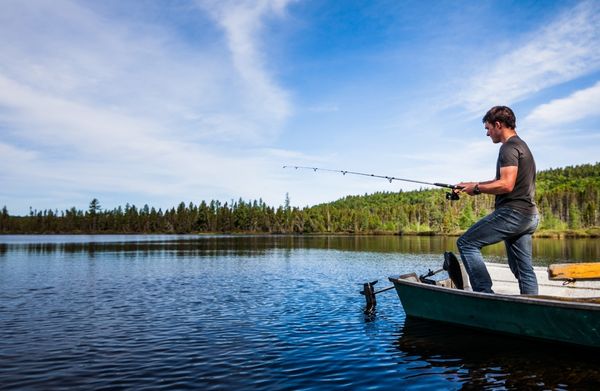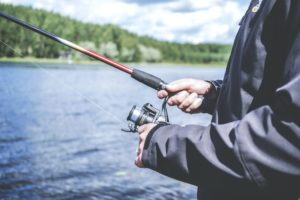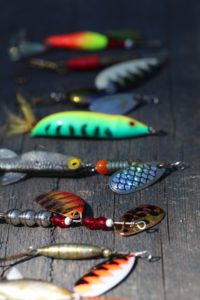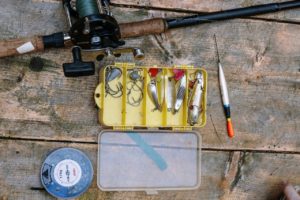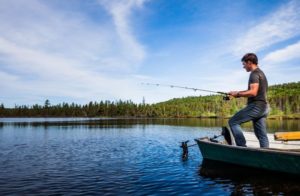
Whether you’re an experienced angler or a beginner, the right gear can make all the difference to catching the fish you want .
In this guide, we’ll walk you through the essential items you need to go fishing, from rods and reels to bait and lures, tackle boxes, fishing clothes and safety gear.
Without the right gear, you could miss out on catching that coveted fish or endanger yourself and others. That’s why it’s important to stock up on the right gear before you hit the water.
This guide will tell you everything you need to know about fishing. Whether you’re fishing freshwater or saltwater, from the bank or from a boat, this guide will help you choose the right gear and accessories for a successful fishing trip .
So let’s get started and make sure you have everything you need for your next fishing adventure.
Inhaltsverzeichnis
Fishing rod and reel
The fishing rod and reel are two of the most important pieces of equipment for any angler . You can decide about your fishing experience. That’s why it’s important to choose the right rod for your needs.
In this section you will learn everything you need to know about fishing rods and reels, e.g. B. what types there are, how to choose the right length, action and reel size and which fishing rod and reel combinations are recommended.
Types of fishing rods and reels
There are different types of fishing rods, each designed for a specific type of fishing or species of fish. Some common types of fishing rods are:
- spinning rods
- Baitcasting-Ruten
- fly rods
- Trolling routes.
Likewise, there are different types of fishing reels, including:
- spinning reels
- Baitcasting-Rollen
- Spincast Reels.
Each type has its own characteristics and advantages and is therefore suitable for different fishing styles and techniques.
Choosing the right rod length, action and reel size
When choosing a fishing rod and reel it is important to consider several factors including rod length, action and reel size.
- The length of the rod determines how far you can cast and how much control you have over the fish.
- The action of the rod refers to its flexibility and how much it bends when pressure is applied.
- Finally, the reel size should be chosen based on the line weight and the type of fishing you intend to do.
Recommended fishing rod and reel combinations
Choosing the right fishing rod and reel can be overwhelming, especially if you are new to fishing. So we’ve put together a list of recommended rod and reel combinations to get you started.
- For freshwater fishing, we recommend the Ugly Stik GX2 Spinning Combo , a sturdy and versatile option that will handle a variety of fish species.
- For saltwater fishing, the Penn Battle II Combo is a great choice with its powerful drag system and corrosion-resistant construction.
- For fly fishing we recommend the Orvis Clearwater Fly Rod and Reel Combo which offers excellent precision and control.
fishing line and hook
Fishing line and hook are two of the most important components of your fishing kit and they can greatly affect your success on the water .
In this section you will learn everything you need to know about fishing lines, hooks, sinkers and swivels. We’ll cover the different types of fishing line, how to choose the right hook size and style for different fish species, and the importance of using sinkers and swivels.
Types of Fishing Lines
There are three main types of fishing line: monofilament, fluorinated and braided.
- Monofilament is the most common type of fishing line and is known for its stretch and versatility.
- Fluorocarbon is a more delicate and durable variety that is invisible underwater, making it a good choice for fishing in clear water.
- Braided lines are the strongest and most delicate of the three, but they can be more visible and more difficult to manipulate.
Choosing the right hook size and style
When choosing a hook, it’s important to choose the size and style that works best for the type of fish you’re trying to catch . Hook sizes range from small (size 32) to large (size 19/0), with larger hooks typically being used for larger fish.
The type of hook can also affect your success: J-hooks, circle hooks, and treble hooks each offer their own advantages.
Importance of using sinkers and eddies
Sinkers and swivels are important accessories that can greatly enhance your fishing experience. Sinkers are weights that attach to the line to help your lure sink to the desired depth.
Swivels are small connectors that allow the line to rotate freely so it doesn’t get tangled. By using sinkers and swivels you can improve your casting accuracy and increase your chances of catching a fish .
Bait and Bait
Lures and bait are important parts of any successful fishing trip. Whether you’re using live bait or artificial bait, choosing the right bait for the type of fish you’re targeting is crucial.
In this section, we will go over the different types of live baits and lures, how to choose the best baits for different species of fish, and provide examples and links to recommended baits and lures.
Types of live baits and artificial baits
The type of bait you use will depend on the species of fish you are targeting and the fishing conditions.
- Live baits such as worms, minnows, and crickets are commonly used to attract fish.
- Artificial lures such as jigs, spinners, and crankbaits are designed to imitate the movements and appearance of prey and entice the fish to bite.
Selection of the best baits and baits
Choosing the best baits can be a bit of a hit-and-miss, but there are a few general rules to keep in mind.
First, consider the type of fish you are targeting and what they typically eat. For example, if you’re fishing for bass, plastic worms or jigs may be more effective, while for trout, live bait like worms or salmon eggs is best.
You should also consider fishing conditions such as water temperature and clarity as this can affect the types of baits that are most effective.
Recommended baits and baits
There are countless options when it comes to baits and baits, but some of the most popular include live baits like worms, minnows, and crickets, as well as artificial baits like jigs, spinners, and crankbaits.
Some recommended options for certain species of fish are topwater baits for bass, soft plastic baits for walleye, and spinners for trout.
When choosing bait, it can be helpful to consult with local tackle shops or fishing guides who have experience in the area.
tackle box
A well-organized tackle box is the be-all and end-all for a successful fishing trip. Without a proper storage system, you’ll have a hard time finding the gear you need when the fish bite .
In this section, we’ll look at the different types of tackle boxes and show you how to organize them so you can easily find your tackle.
Types of tackle boxes
There are different types of fishing boxes, e.g. B. Soft-sided bags, hard plastic boxes and backpacks.
- Soft-sided bags are ideal for anglers who want to travel light and transport their gear easily.
- Hard plastic boxes are more durable and can be fitted with trays or compartments to keep gear separate.
- Backpacks are the most versatile, allowing anglers to carry their gear on long hikes or walks to remote fishing spots.
Organize your tackle box
Organizing your tackle box is just as important as having the right gear. When organizing your tackle box, you should organize your gear by type and size.
For example, you could keep all your hooks in one compartment, all your sinkers in another, and all your baits in another. So you can quickly find the gear you need when the fish bite.
Recommended tackle boxes
There are many tackle boxes on the market, but some are the best. For example, the Plano 7771 Guide Series Tackle Box is a good choice for anglers who need a lot of storage space. The box has four compartments and additional storage space in the top compartment.
The Wild River Nomad XP Lighted Backpack is another great choice for anglers who need to take their gear with them on long hikes. The backpack has a built-in LED light system and offers space for up to four compartments with equipment.
Fishing clothing and accessories
A successful fishing trip depends not only on the right equipment, but also on the right clothing and accessories.
The right clothing and accessories can make a world of difference when it comes to comfort and protection from the sun, wind and rain .
In this section we introduce you to the essential clothing and accessories you need to make your fishing trip more comfortable and enjoyable.
Importance of the right clothing and accessories when fishing
The right clothing and accessories when fishing are critical to your comfort and protection. When fishing, you often spend many hours outdoors in changing weather conditions. Also, the right clothing and accessories can help you avoid injuries and discomfort that can spoil your overall experience.
Choosing the right sunglasses, hat, gloves and boots
- sunglasses
Wearing sunglasses while fishing is important to protect your eyes from harmful UV rays and to help you see fish and other objects in the water. When choosing your sunglasses, look for polarized lenses that reduce glare and improve visibility in the water. The size and shape of the sunglasses should fit your face well for maximum protection and comfort.
- Hut
A hat is an essential accessory for any fishing trip. A wide-brimmed hat can protect your face and neck from the sun, while a cap will protect your eyes from the glare. When choosing a hat, look for lightweight, breathable material that will keep you cool and comfortable.
- Gloves
Fishing gloves protect your hands from blisters, cuts and abrasions caused by handling fish and fishing gear. They also provide extra grip when handling wet gear or fish. When choosing gloves, pay attention to the material, size and grip. Neoprene gloves are a popular choice because they are waterproof and offer good grip.
Proper footwear is essential when fishing, especially if you plan to wade in the water. Look for boots that provide comfortable support, are lightweight, and prevent slipping on wet rocks or uneven surfaces. Choose boots made of breathable and quick-drying materials that will keep your feet dry and comfortable all day long.
Recommended fishing clothing and accessories
- Columbia Sportswear
Columbia Sportswear offers a wide range of quality fishing apparel and accessories including shirts, trousers, hats, gloves and boots. The clothing is equipped with advanced moisture-wicking technology that keeps you dry and comfortable even in hot and humid weather.
- Simms Fishing Products
Simms Fishing Products is another popular brand that offers top quality fishing clothing and accessories. Their clothing is made of durable and high-performance materials that can withstand even the toughest fishing conditions. Simms also offers a wide range of boots and waders that offer excellent protection and comfort while wading in the water.
safety equipment
Fishing can be a fun and relaxing activity, but it’s important that safety always comes first. Whether you’re fishing from a boat or from shore, accidents can happen and it’s important that you’re prepared with the right safety gear.
In this section, we look at the importance of having the right safety gear when fishing and provide recommendations for the gear you should have with you on any fishing trip.
The importance of the right safety equipment
Safety should always come first when fishing. Even if you are an experienced angler, you never know what can happen on the water.
Some of the risks of fishing include slipping and falling on wet rocks, tangling in fishing line, and falling overboard. That’s why it’s important that you have the right safety gear with you to protect you and your fellow anglers.
Choosing the right safety gear for fishing
When it comes to fishing safety gear, there are a few essential items that every angler should have with them. First and foremost, a life jacket is a must for anyone fishing on a boat or in deep water.
Choose a life jacket that fits well and is appropriate for your weight and size. It’s also a good idea to have a whistle or other signaling device on your life jacket in case of an emergency.
Another important piece of safety equipment is a first aid kit. You never know when an accident can happen. It is therefore important that you always have a well-stocked first aid kit with you. Make sure your kit includes bandages, gauze, antiseptic wipes, pain relievers, and any medication you need.
Recommended safety equipment for fishing
Here are some examples of recommended fishing safety gear:
- Gogokids Kids Life Jacket Flotation Jacket* : This is a great life jacket for kids who are on the boat or on the water fishing. It’s comfortable, lightweight and comes in fun colors that kids will love.
- Leader International Buoyancy Aid Adult* : This is a great life jacket for adults who fish from boats or kayaks. It’s comfortable and breathable and has plenty of pockets to stash your gear.
- First Aid Kit – 210 Piece Premium First Aid Kit* : This is a great first aid kit for anglers who want to be prepared for any emergency. It’s lightweight, waterproof, and includes everything you need to treat common fishing injuries.
- Fox 40 Sonik Blast CMG Whistle : This is a loud, reliable whistle that can be heard from afar. It’s a great signaling device to have with you in an emergency.
Carrying the right safety gear with you on every fishing trip gives you peace of mind knowing you’re prepared for any situation that may arise.
Conclusion
In summary, the right gear and accessories are essential to a successful fishing trip. We’ve covered the essential items needed for fishing, including fishing rods and reels, fishing lines and hooks, baits and lures, tackle boxes, fishing clothing and accessories, and safety gear.
By following the tips and recommendations in this guide, you can ensure you have everything you need for a great day of fishing.
We encourage all readers to use this information to plan their next fishing trip with confidence. Whether you’re an experienced angler or a beginner, the right gear and knowledge can make all the difference in your fishing experience.
If you are looking for more helpful fishing tips and information, be sure to visit our website. We have made it our task to provide the most accurate and detailed information possible for German anglers interested in fishing.
We also offer helpful articles about fish finders to help you make the most of your time on the water. Thanks for reading and happy fishing!
frequently asked Questions
- What do I need to bring for my first fishing trip?
For your first fishing trip you will need a fishing rod and reel, fishing line, hooks, bait, a tackle box and appropriate clothing and safety gear. - How do I choose the right fishing rod and reel?
When choosing a fishing rod and reel, you should consider the style of fishing, the size and type of fish you are targeting, and your own skill level. Look for a rod with the right length and action for your needs and a reel that can handle the size of fish you’re trying to catch. - Which baits should I use?
The bait you should use will depend on the species of fish you are targeting and the fishing conditions. Live baits can be effective for some species of fish, while others respond better to artificial baits. Experiment with different types of bait to find what works best for you. - How should I organize my tackle box?
When organizing your tackle box, group similar items together and label each compartment. Store frequently used items in easy-to-reach places and store less frequently used items at the bottom or in the back of the box. Consider using clear plastic compartments to make it easier to find what you need. - What safety equipment do I need for fishing?
You should always wear a life jacket or flotation device when fishing, especially if you are on a boat or in deep water. You should also take a first aid kit with you in case of emergencies. It’s also important to be aware of your surroundings and follow all fishing and boating rules to stay safe on the water. - Where can I find more information about fishing equipment and techniques?
For more information on fishing equipment and techniques, visit our website or ask a local angler. You can also find helpful resources online, such as fishing blogs and forums, instructional videos, and fishing equipment reviews.

